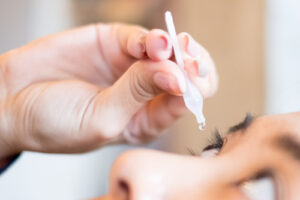Dry eye and ocular surface disease can significantly impact a person’s quality of life and vision. At Takle Eye Group, Dr. Ruchi Gandhi specializes in providing comprehensive dry eye evaluations and personalized treatment plans to help improve dry eye symptoms.
What is Dry Eye and Ocular Surface Disease?
Dry eye and ocular surface disease encompass a group of conditions that affect the outermost layer of the eye, called the cornea. Conditions affecting the cornea can lead to discomfort and potential vision problems.

Dry eye, the most common form, occurs when the eyes do not produce enough tears or when the tears evaporate too quickly, resulting in insufficient lubrication. This can lead to a variety of uncomfortable symptoms and can even affect your vision.
Ocular surface disease is a broader term that includes dry eye along with other conditions like blepharitis and meibomian gland dysfunction, sometimes called MGD. MGD occurs when the meibomian glands in the eyelids become blocked, reducing the production of the oily layer of the tear film, which leads to faster tear evaporation.
Blepharitis is characterized by inflammation of the eyelids and can often accompany MGD. Effective management of dry eye and ocular surface disease involves identifying the underlying causes and providing personalized treatment plans.
At Takle Eye Group, Dr. Gandhi specializes in comprehensive dry eye evaluations and offers various innovative treatments to help alleviate symptoms and enhance overall ocular health. Early diagnosis and treatment are crucial to maintaining clear vision and improving the quality of life for those affected by these conditions.
What Are the Most Common Symptoms of Dry Eye?
Dry eyes can cause various symptoms and may present differently in different people. Some of the most common symptoms of dry eye are:
- Persistent dryness or grittiness in the eyes
- Redness and inflammation
- The sensation of burning or stinging
- Blurred vision
- Light sensitivity
- Eye fatigue or discomfort, especially after prolonged visual tasks
- Difficulty wearing contact lenses
Dry eye symptoms can range from mild to severe. For many people, these symptoms fluctuate throughout the day or worsen in certain environmental conditions.
Those who are experiencing dry eye may find their symptoms are worse in windy or dry climates, in environments with air conditioning, or during extended periods of time looking at screens. Activities that require visual focus, like reading, for example, can intensify dry eye symptoms.
Untreated, dry eye can have a significant impact on daily life, including affecting your work productivity and overall quality of life.
What Causes Dry Eye?
Anyone can develop dry eyes at any point in their life. However, it is thought that several factors may contribute to the development of dry eye, such as:
Age
The risk of dry eye increases with age, especially in individuals over fifty.
Gender
Women, particularly after menopause, are more prone to dry eyes.
Environmental Factors
Air conditioning, dry or windy climates, and prolonged screen time can make dry eye symptoms worse.
Medical Conditions
Certain health conditions, like autoimmune diseases and thyroid disorders, can contribute to dry eye.
Medications
Some medications, like antihistamines, decongestants, and antidepressants, may decrease tear production.
Ocular Rosacea
Ocular rosacea can cause dry eye by inducing inflammation of the ocular surface and meibomian glands, leading to reduced tear production and increased evaporation of tears.
What Treatment Options Are Available For Dry Eye?
At Takle Eye Group in Griffin, Georgia, Dr. Gandhi offers personalized dry eye treatment plans tailored to each person’s specific needs. In some cases, he may recommend increasing your use of artificial tears to help improve lubrication.

There are also some lifestyle modifications you may be able to make to help improve your symptoms, like increasing your intake of Omega-3 fatty acids and other supplements that may support eye health. Dr. Gandhi may prescribe you eye drops to help improve your dry eye.
Another option he may recommend is meibomian gland expression. This is a technique to clear blocked meibomian glands, which play a crucial role in tear production.
In case these methods do not sufficiently alleviate your dry eye symptoms, Dr. Gandhi may recommend in-office treatments as an alternative. At Takle Eye Group, we are proud to offer advanced dry eye treatment options, including TearCare and OptiLight IPL.
TearCare and OptiLight IPL are convenient in-office procedures designed to effectively target dry eye symptoms while improving the health of your cornea. These innovative treatments aim to provide lasting relief from discomfort and improve the overall well-being of your eyes.
What is TearCare?
TearCare is a state-of-the-art dry eye treatment offered exclusively at our Locust Grove location. This personalized, in-office procedure is designed to provide effective relief for those experiencing dry eye symptoms.
During the TearCare treatment, regulated heat is applied to the eyelids, specifically targeting the meibomian glands. These glands play a vital role in producing the oily layer of tears that prevents rapid evaporation.
By stimulating the meibomian glands, TearCare promotes better tear production, enhancing the quality and quantity of tears on the ocular surface. The procedure is known for its comfort and non-invasiveness.
Patients can relax during the treatment while experiencing minimal to no discomfort. TearCare’s innovative approach offers a significant advantage over traditional methods, as it targets the root cause of dry eye directly, leading to more lasting and effective results.
What is OptiLight IPL?
OptiLight IPL, also known as Intense Pulsed Light, is an advanced and highly effective dry eye therapy that is also available at our Locust Grove location. This innovative treatment utilizes non-laser light pulses to specifically target the root causes of dry eye, such as inflammation of the eyelids and dysfunction of the meibomian glands.
The OptiLight IPL system utilizes a sophisticated technology that emits gentle light pulses to the affected areas around the eyes. These light pulses penetrate the skin’s surface, precisely targeting and reducing inflammation in the meibomian glands and the surrounding tissue.
By addressing these underlying issues, OptiLight IPL promotes healthier tear production and improves the overall health of the ocular surface. The treatment not only reduces discomfort but also helps restore the natural balance of your tears, ensuring a significant improvement in the quality of your vision and eye comfort.
Are you experiencing dry eye symptoms? Schedule an appointment at Takle Eye Group in Locust Grove, GA, today!




